Wind Augmentation Shroud Design
VerifiedAdded on 2019/09/16
|20
|6062
|438
Thesis and Dissertation
AI Summary
This thesis presents a comparative study and design of a custom-constructed wind augmentation shroud to enhance the efficiency of wind turbine power output. The research addresses the increasing need for alternative energy sources and focuses on improving wind turbine technology, particularly in remote areas with turbulent wind patterns. The study investigates the use of wind shroud systems, which increase the cross-sectional area of flowing wind, drawing more air through the turbine blades and generating more power. The thesis reviews existing literature on shrouded wind systems, including various designs and their performance characteristics. It then details the design process of a novel wind shroud with a wind guide attachment, utilizing Creo Parametric 3.0 software for design and SPSS Statistics 23 for data analysis. The research aims to determine the optimal design parameters, such as inlet angle and shape of the wind guide attachment, to maximize wind velocity and power output. The significance of the study lies in its potential to contribute to a more efficient and cost-effective way of harnessing wind energy, particularly in areas lacking access to electricity.
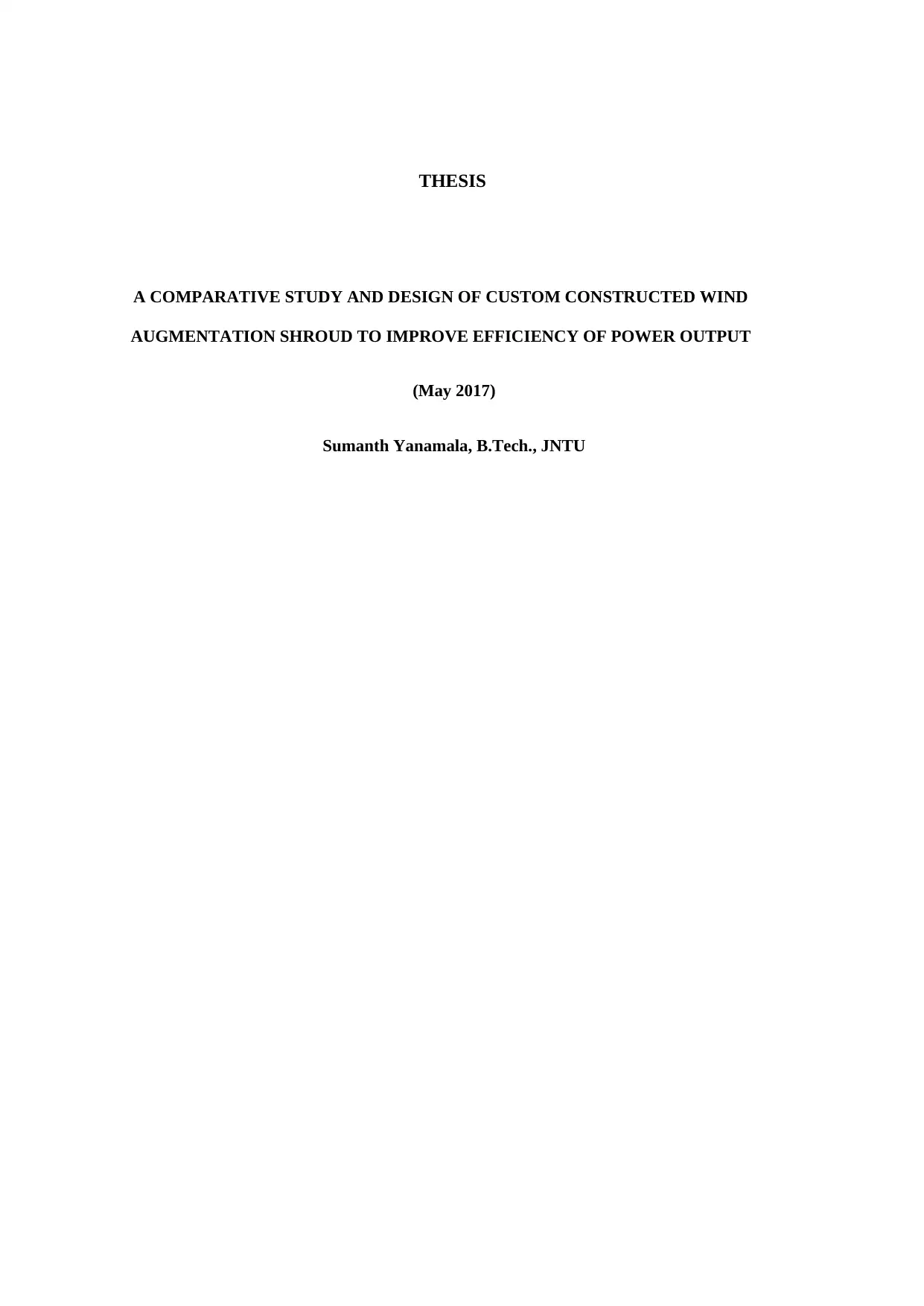
THESIS
A COMPARATIVE STUDY AND DESIGN OF CUSTOM CONSTRUCTED WIND
AUGMENTATION SHROUD TO IMPROVE EFFICIENCY OF POWER OUTPUT
(May 2017)
Sumanth Yanamala, B.Tech., JNTU
A COMPARATIVE STUDY AND DESIGN OF CUSTOM CONSTRUCTED WIND
AUGMENTATION SHROUD TO IMPROVE EFFICIENCY OF POWER OUTPUT
(May 2017)
Sumanth Yanamala, B.Tech., JNTU
Paraphrase This Document
Need a fresh take? Get an instant paraphrase of this document with our AI Paraphraser

CHAPTER 1
INTRODUCTION
Alternative sources of energy are vital for application of efficient power sources
in the future. The other sources such as fossil fuel are reducing at a very high rate and
causing issues such as environmental degradation and global warming. Creation of
better ways of generating energy as well as utilising renewable and clean energy should
be highly invested on. Among others, innovations in wind energy have been developing
rapidly and are expected to play a fundamental role in the field of energy (Isensee &
Abdul, 2012). However, a comparative study between the rate of using wind power and
the overall demand for energy is still subtle especially the level of development is
negligible in the remote area.
Remote areas suitable for the development of wind power plants, complex
terrains and the turbulent nature of the local winds are affecting the installation of wind
turbines. Therefore, the introduction of new and innovative wind energy systems that
produce high output regardless of the wind speed and patterns are desired.
It is imperative to understand better various ways of improving the efficiency of
wind turbines, as well as bringing down the cost to an economical level. The cost of oil
and other non-renewable resources are on the rise every day (Carroll, 2014). Improving
the efficiency of wind turbines helps in reducing the energy limits being experienced
today. In the future, turbines will be able to harness more energy from the wind with
limited technological improvements.
A considerable number of high-efficiency turbines lowers the cost of energy as well
as generate power at a lower cost. Wind shroud system is one of the major techniques
2
INTRODUCTION
Alternative sources of energy are vital for application of efficient power sources
in the future. The other sources such as fossil fuel are reducing at a very high rate and
causing issues such as environmental degradation and global warming. Creation of
better ways of generating energy as well as utilising renewable and clean energy should
be highly invested on. Among others, innovations in wind energy have been developing
rapidly and are expected to play a fundamental role in the field of energy (Isensee &
Abdul, 2012). However, a comparative study between the rate of using wind power and
the overall demand for energy is still subtle especially the level of development is
negligible in the remote area.
Remote areas suitable for the development of wind power plants, complex
terrains and the turbulent nature of the local winds are affecting the installation of wind
turbines. Therefore, the introduction of new and innovative wind energy systems that
produce high output regardless of the wind speed and patterns are desired.
It is imperative to understand better various ways of improving the efficiency of
wind turbines, as well as bringing down the cost to an economical level. The cost of oil
and other non-renewable resources are on the rise every day (Carroll, 2014). Improving
the efficiency of wind turbines helps in reducing the energy limits being experienced
today. In the future, turbines will be able to harness more energy from the wind with
limited technological improvements.
A considerable number of high-efficiency turbines lowers the cost of energy as well
as generate power at a lower cost. Wind shroud system is one of the major techniques
2
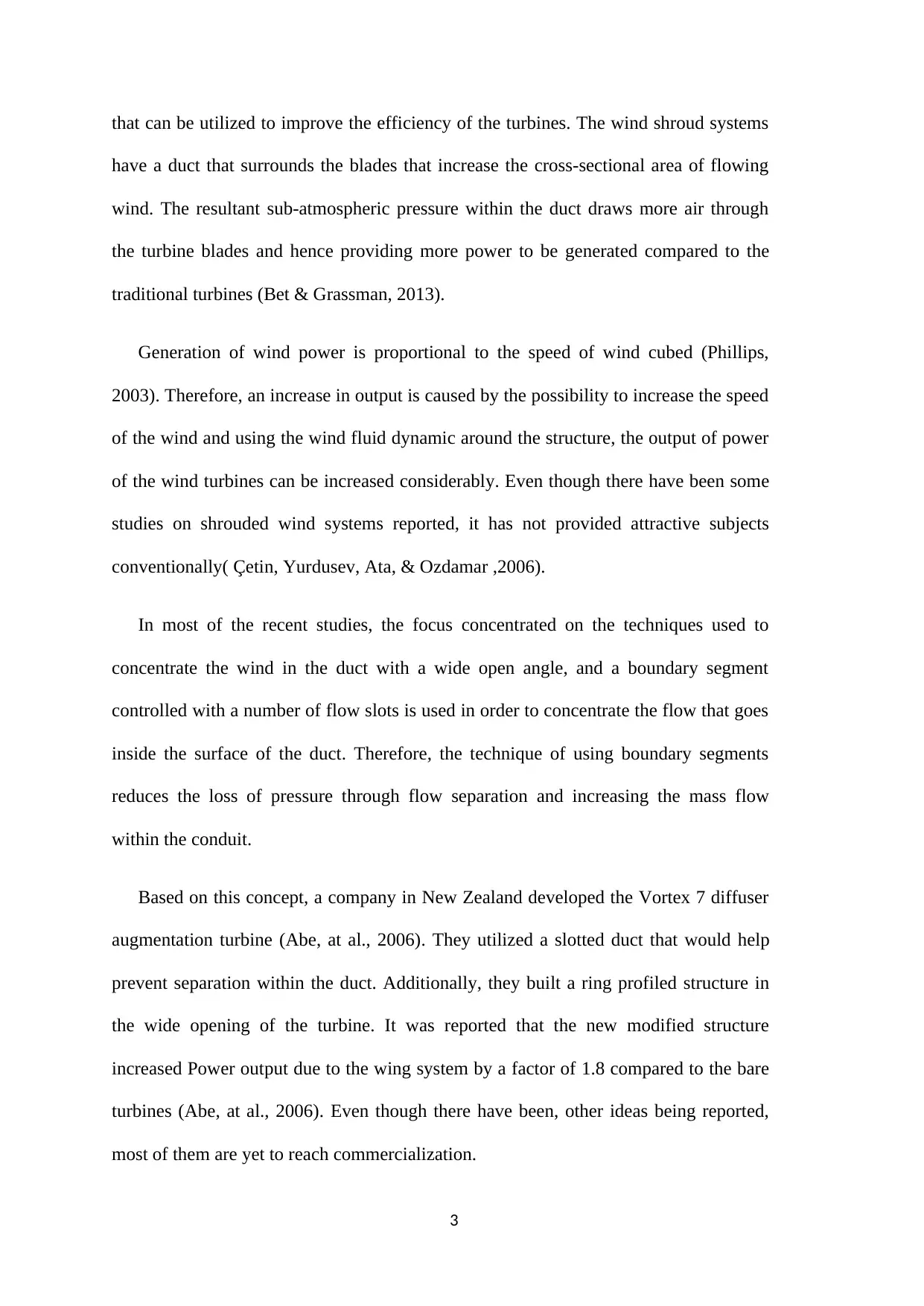
that can be utilized to improve the efficiency of the turbines. The wind shroud systems
have a duct that surrounds the blades that increase the cross-sectional area of flowing
wind. The resultant sub-atmospheric pressure within the duct draws more air through
the turbine blades and hence providing more power to be generated compared to the
traditional turbines (Bet & Grassman, 2013).
Generation of wind power is proportional to the speed of wind cubed (Phillips,
2003). Therefore, an increase in output is caused by the possibility to increase the speed
of the wind and using the wind fluid dynamic around the structure, the output of power
of the wind turbines can be increased considerably. Even though there have been some
studies on shrouded wind systems reported, it has not provided attractive subjects
conventionally( Çetin, Yurdusev, Ata, & Ozdamar ,2006).
In most of the recent studies, the focus concentrated on the techniques used to
concentrate the wind in the duct with a wide open angle, and a boundary segment
controlled with a number of flow slots is used in order to concentrate the flow that goes
inside the surface of the duct. Therefore, the technique of using boundary segments
reduces the loss of pressure through flow separation and increasing the mass flow
within the conduit.
Based on this concept, a company in New Zealand developed the Vortex 7 diffuser
augmentation turbine (Abe, at al., 2006). They utilized a slotted duct that would help
prevent separation within the duct. Additionally, they built a ring profiled structure in
the wide opening of the turbine. It was reported that the new modified structure
increased Power output due to the wing system by a factor of 1.8 compared to the bare
turbines (Abe, at al., 2006). Even though there have been, other ideas being reported,
most of them are yet to reach commercialization.
3
have a duct that surrounds the blades that increase the cross-sectional area of flowing
wind. The resultant sub-atmospheric pressure within the duct draws more air through
the turbine blades and hence providing more power to be generated compared to the
traditional turbines (Bet & Grassman, 2013).
Generation of wind power is proportional to the speed of wind cubed (Phillips,
2003). Therefore, an increase in output is caused by the possibility to increase the speed
of the wind and using the wind fluid dynamic around the structure, the output of power
of the wind turbines can be increased considerably. Even though there have been some
studies on shrouded wind systems reported, it has not provided attractive subjects
conventionally( Çetin, Yurdusev, Ata, & Ozdamar ,2006).
In most of the recent studies, the focus concentrated on the techniques used to
concentrate the wind in the duct with a wide open angle, and a boundary segment
controlled with a number of flow slots is used in order to concentrate the flow that goes
inside the surface of the duct. Therefore, the technique of using boundary segments
reduces the loss of pressure through flow separation and increasing the mass flow
within the conduit.
Based on this concept, a company in New Zealand developed the Vortex 7 diffuser
augmentation turbine (Abe, at al., 2006). They utilized a slotted duct that would help
prevent separation within the duct. Additionally, they built a ring profiled structure in
the wide opening of the turbine. It was reported that the new modified structure
increased Power output due to the wing system by a factor of 1.8 compared to the bare
turbines (Abe, at al., 2006). Even though there have been, other ideas being reported,
most of them are yet to reach commercialization.
3
⊘ This is a preview!⊘
Do you want full access?
Subscribe today to unlock all pages.

Trusted by 1+ million students worldwide

The primary objective of the present study concerning developing a wind system
with higher output is determining the best way to harness wind energy in a more
efficient way as well as the right shroud that can be used to generate energy more
efficiently. As an alternative, the shrouded wind system technology might provide
energy to areas with turbulent wind patterns as well as other remote areas, where
electricity is yet to be installed. In fact, shrouded wind systems are an attractive
alternative for the developing market especially for areas that lack electricity or areas
with energy deficiency.
Shrouded wind systems have many advantages over the bare turbines. The newly
innovated turbines are easy to install since they have a shorter construction period that
is extending the utility grid line. This turbine technology has been reported to be lesser
complex to construct (Hirahara, Hossain, Kawahashi & Nonomura, 2005). As for the
reasons, local manufacturing is usually a preferred option in remote areas or developing
areas that could, in turn, boost economic development as well as reducing the cost of
production.
This model of turbine technology would also increase the wind velocity through the
blades which include small inlet shroud and a diffuser. A low-pressure area is usually
generated behind the diffuser as vortices are created. Not only there is a huge
development in the wind industry in regard to power production through the wind
turbines, but also on the effectiveness of the turbines used. Recent research shows that
researcher is looking for much better ways of improving and increasing the
effectiveness and applicability of the present wind turbines (Hirahara, et al., 2006).
4
with higher output is determining the best way to harness wind energy in a more
efficient way as well as the right shroud that can be used to generate energy more
efficiently. As an alternative, the shrouded wind system technology might provide
energy to areas with turbulent wind patterns as well as other remote areas, where
electricity is yet to be installed. In fact, shrouded wind systems are an attractive
alternative for the developing market especially for areas that lack electricity or areas
with energy deficiency.
Shrouded wind systems have many advantages over the bare turbines. The newly
innovated turbines are easy to install since they have a shorter construction period that
is extending the utility grid line. This turbine technology has been reported to be lesser
complex to construct (Hirahara, Hossain, Kawahashi & Nonomura, 2005). As for the
reasons, local manufacturing is usually a preferred option in remote areas or developing
areas that could, in turn, boost economic development as well as reducing the cost of
production.
This model of turbine technology would also increase the wind velocity through the
blades which include small inlet shroud and a diffuser. A low-pressure area is usually
generated behind the diffuser as vortices are created. Not only there is a huge
development in the wind industry in regard to power production through the wind
turbines, but also on the effectiveness of the turbines used. Recent research shows that
researcher is looking for much better ways of improving and increasing the
effectiveness and applicability of the present wind turbines (Hirahara, et al., 2006).
4
Paraphrase This Document
Need a fresh take? Get an instant paraphrase of this document with our AI Paraphraser
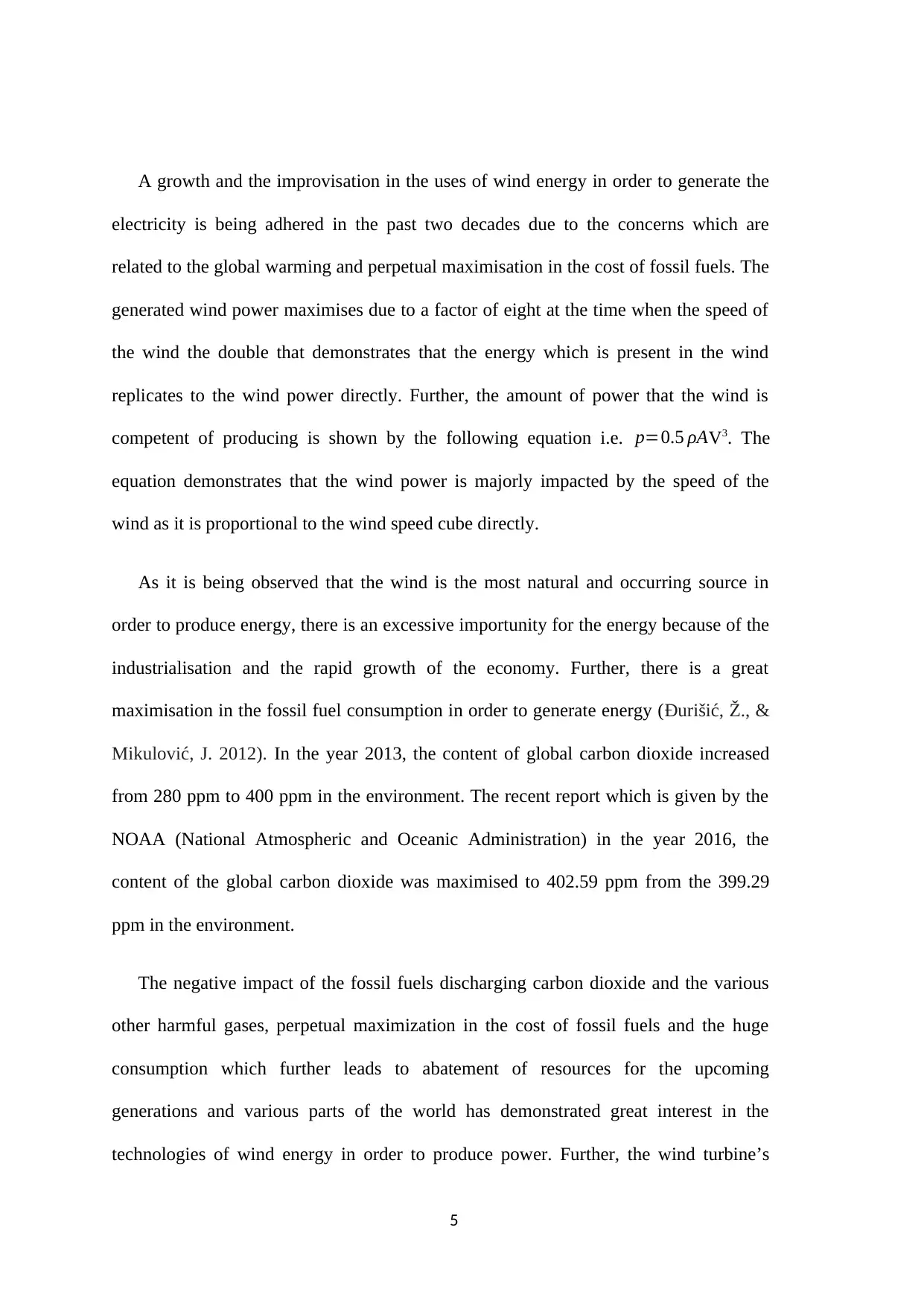
A growth and the improvisation in the uses of wind energy in order to generate the
electricity is being adhered in the past two decades due to the concerns which are
related to the global warming and perpetual maximisation in the cost of fossil fuels. The
generated wind power maximises due to a factor of eight at the time when the speed of
the wind the double that demonstrates that the energy which is present in the wind
replicates to the wind power directly. Further, the amount of power that the wind is
competent of producing is shown by the following equation i.e. p=0.5 ρAV3. The
equation demonstrates that the wind power is majorly impacted by the speed of the
wind as it is proportional to the wind speed cube directly.
As it is being observed that the wind is the most natural and occurring source in
order to produce energy, there is an excessive importunity for the energy because of the
industrialisation and the rapid growth of the economy. Further, there is a great
maximisation in the fossil fuel consumption in order to generate energy (Đurišić, Ž., &
Mikulović, J. 2012). In the year 2013, the content of global carbon dioxide increased
from 280 ppm to 400 ppm in the environment. The recent report which is given by the
NOAA (National Atmospheric and Oceanic Administration) in the year 2016, the
content of the global carbon dioxide was maximised to 402.59 ppm from the 399.29
ppm in the environment.
The negative impact of the fossil fuels discharging carbon dioxide and the various
other harmful gases, perpetual maximization in the cost of fossil fuels and the huge
consumption which further leads to abatement of resources for the upcoming
generations and various parts of the world has demonstrated great interest in the
technologies of wind energy in order to produce power. Further, the wind turbine’s
5
electricity is being adhered in the past two decades due to the concerns which are
related to the global warming and perpetual maximisation in the cost of fossil fuels. The
generated wind power maximises due to a factor of eight at the time when the speed of
the wind the double that demonstrates that the energy which is present in the wind
replicates to the wind power directly. Further, the amount of power that the wind is
competent of producing is shown by the following equation i.e. p=0.5 ρAV3. The
equation demonstrates that the wind power is majorly impacted by the speed of the
wind as it is proportional to the wind speed cube directly.
As it is being observed that the wind is the most natural and occurring source in
order to produce energy, there is an excessive importunity for the energy because of the
industrialisation and the rapid growth of the economy. Further, there is a great
maximisation in the fossil fuel consumption in order to generate energy (Đurišić, Ž., &
Mikulović, J. 2012). In the year 2013, the content of global carbon dioxide increased
from 280 ppm to 400 ppm in the environment. The recent report which is given by the
NOAA (National Atmospheric and Oceanic Administration) in the year 2016, the
content of the global carbon dioxide was maximised to 402.59 ppm from the 399.29
ppm in the environment.
The negative impact of the fossil fuels discharging carbon dioxide and the various
other harmful gases, perpetual maximization in the cost of fossil fuels and the huge
consumption which further leads to abatement of resources for the upcoming
generations and various parts of the world has demonstrated great interest in the
technologies of wind energy in order to produce power. Further, the wind turbine’s
5
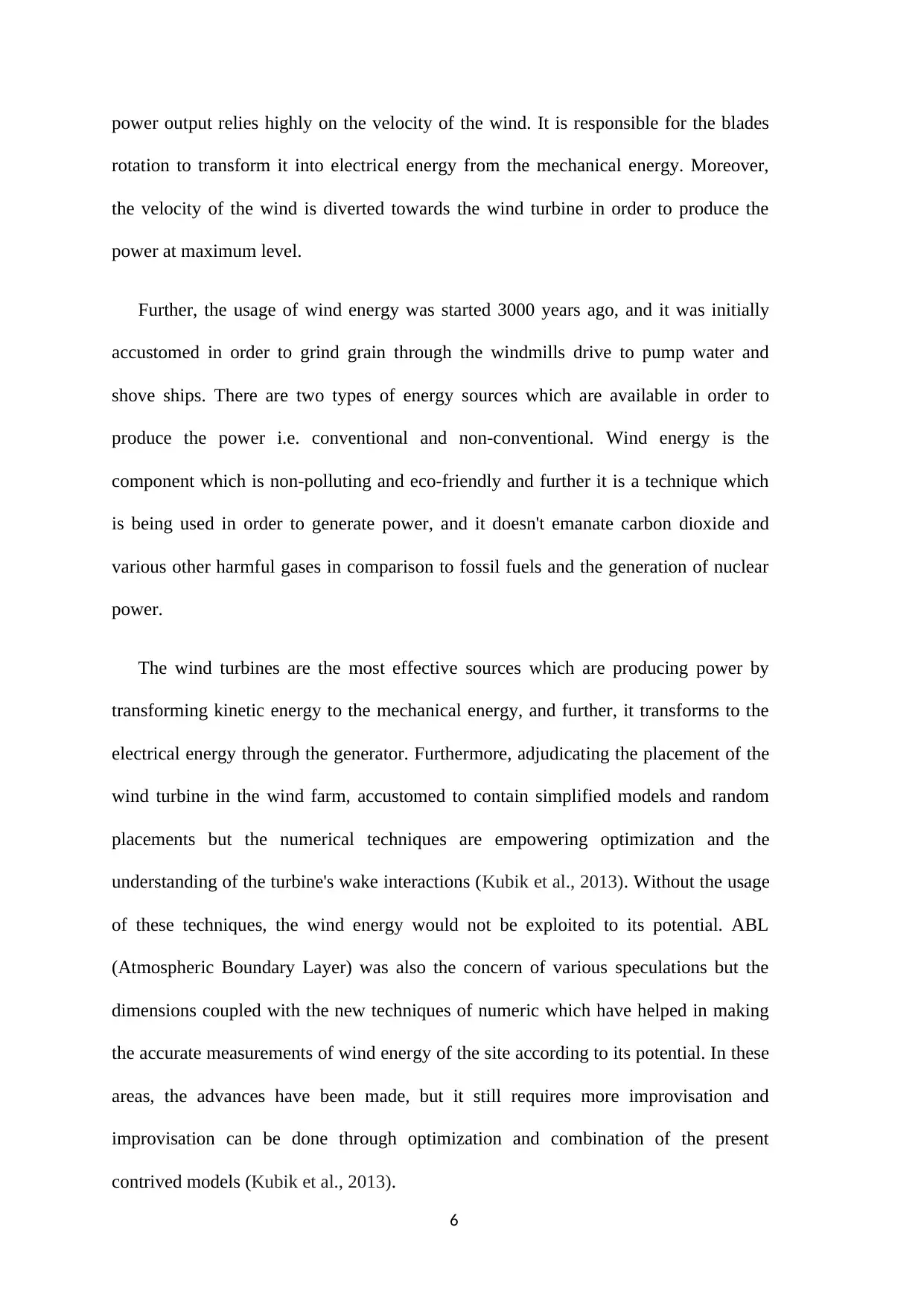
power output relies highly on the velocity of the wind. It is responsible for the blades
rotation to transform it into electrical energy from the mechanical energy. Moreover,
the velocity of the wind is diverted towards the wind turbine in order to produce the
power at maximum level.
Further, the usage of wind energy was started 3000 years ago, and it was initially
accustomed in order to grind grain through the windmills drive to pump water and
shove ships. There are two types of energy sources which are available in order to
produce the power i.e. conventional and non-conventional. Wind energy is the
component which is non-polluting and eco-friendly and further it is a technique which
is being used in order to generate power, and it doesn't emanate carbon dioxide and
various other harmful gases in comparison to fossil fuels and the generation of nuclear
power.
The wind turbines are the most effective sources which are producing power by
transforming kinetic energy to the mechanical energy, and further, it transforms to the
electrical energy through the generator. Furthermore, adjudicating the placement of the
wind turbine in the wind farm, accustomed to contain simplified models and random
placements but the numerical techniques are empowering optimization and the
understanding of the turbine's wake interactions (Kubik et al., 2013). Without the usage
of these techniques, the wind energy would not be exploited to its potential. ABL
(Atmospheric Boundary Layer) was also the concern of various speculations but the
dimensions coupled with the new techniques of numeric which have helped in making
the accurate measurements of wind energy of the site according to its potential. In these
areas, the advances have been made, but it still requires more improvisation and
improvisation can be done through optimization and combination of the present
contrived models (Kubik et al., 2013).
6
rotation to transform it into electrical energy from the mechanical energy. Moreover,
the velocity of the wind is diverted towards the wind turbine in order to produce the
power at maximum level.
Further, the usage of wind energy was started 3000 years ago, and it was initially
accustomed in order to grind grain through the windmills drive to pump water and
shove ships. There are two types of energy sources which are available in order to
produce the power i.e. conventional and non-conventional. Wind energy is the
component which is non-polluting and eco-friendly and further it is a technique which
is being used in order to generate power, and it doesn't emanate carbon dioxide and
various other harmful gases in comparison to fossil fuels and the generation of nuclear
power.
The wind turbines are the most effective sources which are producing power by
transforming kinetic energy to the mechanical energy, and further, it transforms to the
electrical energy through the generator. Furthermore, adjudicating the placement of the
wind turbine in the wind farm, accustomed to contain simplified models and random
placements but the numerical techniques are empowering optimization and the
understanding of the turbine's wake interactions (Kubik et al., 2013). Without the usage
of these techniques, the wind energy would not be exploited to its potential. ABL
(Atmospheric Boundary Layer) was also the concern of various speculations but the
dimensions coupled with the new techniques of numeric which have helped in making
the accurate measurements of wind energy of the site according to its potential. In these
areas, the advances have been made, but it still requires more improvisation and
improvisation can be done through optimization and combination of the present
contrived models (Kubik et al., 2013).
6
⊘ This is a preview!⊘
Do you want full access?
Subscribe today to unlock all pages.

Trusted by 1+ million students worldwide

The numeric methods and the dynamics of the computational fluids can be utilized
in order to anatomize the flow over the complicated terrain to better micro-site the farm
of wind. The coastal areas are the most fascinated locations due to moderately high
speeds of the wind but these regions mostly have an unsteady flow of the wind and the
complicated terrain. The dynamics of the computational fluids can be coupled along
with the algorithms that use spacing, cost, inter-connections of the turbine and
geography in the form of variables to find the great layout of the farm. Further, the
single kind of the turbine at height can be anatomized, and the various other restrictions
and the price are not being considered (McWilliam et al., 2012).
The impact of support structures on the flow of wind might have an effect on the
performance of the turbine. The impacts can be caused by using the characteristics of
the flow, interference of the blade tower, lift forces by using the dynamics of the
computational fluids on the upwind turbine. Further, this model predicted successfully
the flow deterrent from the tower when the blade will pass through it. Despite this, it
doesn't demonstrate that the outcomes were substantiated by experimental data.
Moreover, the interference of tower gives rise to vibrations. The simulation of numeric
and the anatomy of the wind turbine structures of the support and the generation of
noise are the main areas to study because they are accustomed to augur the fatigue life
and minimise a load of fatigue towards the support structure of the turbines of wind
(Carroll, 2014).
The wind turbines can be characterised in two kinds relied on the axis in which the
rotation of the turbines takes place i.e. wind turbine of the horizontal axis and the wind
turbines of the vertical axis. Further, in the horizontal axis, the turbine blades rotate
around the axis of horizontal, and they are mainly pointed to the direction of the wind.
Whereas, the wind turbines of the vertical axis are the kind of turbine of the wind in
7
in order to anatomize the flow over the complicated terrain to better micro-site the farm
of wind. The coastal areas are the most fascinated locations due to moderately high
speeds of the wind but these regions mostly have an unsteady flow of the wind and the
complicated terrain. The dynamics of the computational fluids can be coupled along
with the algorithms that use spacing, cost, inter-connections of the turbine and
geography in the form of variables to find the great layout of the farm. Further, the
single kind of the turbine at height can be anatomized, and the various other restrictions
and the price are not being considered (McWilliam et al., 2012).
The impact of support structures on the flow of wind might have an effect on the
performance of the turbine. The impacts can be caused by using the characteristics of
the flow, interference of the blade tower, lift forces by using the dynamics of the
computational fluids on the upwind turbine. Further, this model predicted successfully
the flow deterrent from the tower when the blade will pass through it. Despite this, it
doesn't demonstrate that the outcomes were substantiated by experimental data.
Moreover, the interference of tower gives rise to vibrations. The simulation of numeric
and the anatomy of the wind turbine structures of the support and the generation of
noise are the main areas to study because they are accustomed to augur the fatigue life
and minimise a load of fatigue towards the support structure of the turbines of wind
(Carroll, 2014).
The wind turbines can be characterised in two kinds relied on the axis in which the
rotation of the turbines takes place i.e. wind turbine of the horizontal axis and the wind
turbines of the vertical axis. Further, in the horizontal axis, the turbine blades rotate
around the axis of horizontal, and they are mainly pointed to the direction of the wind.
Whereas, the wind turbines of the vertical axis are the kind of turbine of the wind in
7
Paraphrase This Document
Need a fresh take? Get an instant paraphrase of this document with our AI Paraphraser

which it rotates vertically. The wind turbines of the vertical axis are the independent of
the direction of the wind and further, there is no need of creating a control system for
the dictate adjustment of the blades, and the turbine can be accustomed in various
places where the direction of the wind is largely variable. The gearboxes and the
generators can be put near to the ground, and as a result, there will be a minimum load
on the tower and the maintenance will be easy.
The main objective behind the development of the wind turbine is maximising the
power outcome of the turbine. Moreover, there are two parameters which impact the
power's value i.e. the blade's swept area and the speed of the wind. The power outcome
can be maximised by maximising one out of the two given parameters. As a result, the
conventional wind turbine the coefficient of the power is a restricted parameter.
Moreover, the method to maximise the velocity of the wind is to utilise the duct across
the rotor (Song et al., 2012). The design is being pertained as the wind turbine of
diffuser augmented. It is being observed that the duct across the rotor maximises the air
flow rate through the swept area with the help of the rotor and maximises the velocity
of the wind at the rotor. The majority of the diffuser was developed on the basis of the
wind turbine of a horizontal axis, and it is being observed that the design of the
diffusers was mainly focused on the applications of the wind turbines of the vertical
axis (Song et al., 2012).
Significance of the study
The significance of the research is to investigate the optimal design of the wind
augmentation shroud and a wind guide attachment in the shroud to improve the power
output of the wind turbine. If this research yields good results, then we can observe a
drastic growth in the production of electricity through wind energy which is clear, safer
8
the direction of the wind and further, there is no need of creating a control system for
the dictate adjustment of the blades, and the turbine can be accustomed in various
places where the direction of the wind is largely variable. The gearboxes and the
generators can be put near to the ground, and as a result, there will be a minimum load
on the tower and the maintenance will be easy.
The main objective behind the development of the wind turbine is maximising the
power outcome of the turbine. Moreover, there are two parameters which impact the
power's value i.e. the blade's swept area and the speed of the wind. The power outcome
can be maximised by maximising one out of the two given parameters. As a result, the
conventional wind turbine the coefficient of the power is a restricted parameter.
Moreover, the method to maximise the velocity of the wind is to utilise the duct across
the rotor (Song et al., 2012). The design is being pertained as the wind turbine of
diffuser augmented. It is being observed that the duct across the rotor maximises the air
flow rate through the swept area with the help of the rotor and maximises the velocity
of the wind at the rotor. The majority of the diffuser was developed on the basis of the
wind turbine of a horizontal axis, and it is being observed that the design of the
diffusers was mainly focused on the applications of the wind turbines of the vertical
axis (Song et al., 2012).
Significance of the study
The significance of the research is to investigate the optimal design of the wind
augmentation shroud and a wind guide attachment in the shroud to improve the power
output of the wind turbine. If this research yields good results, then we can observe a
drastic growth in the production of electricity through wind energy which is clear, safer
8
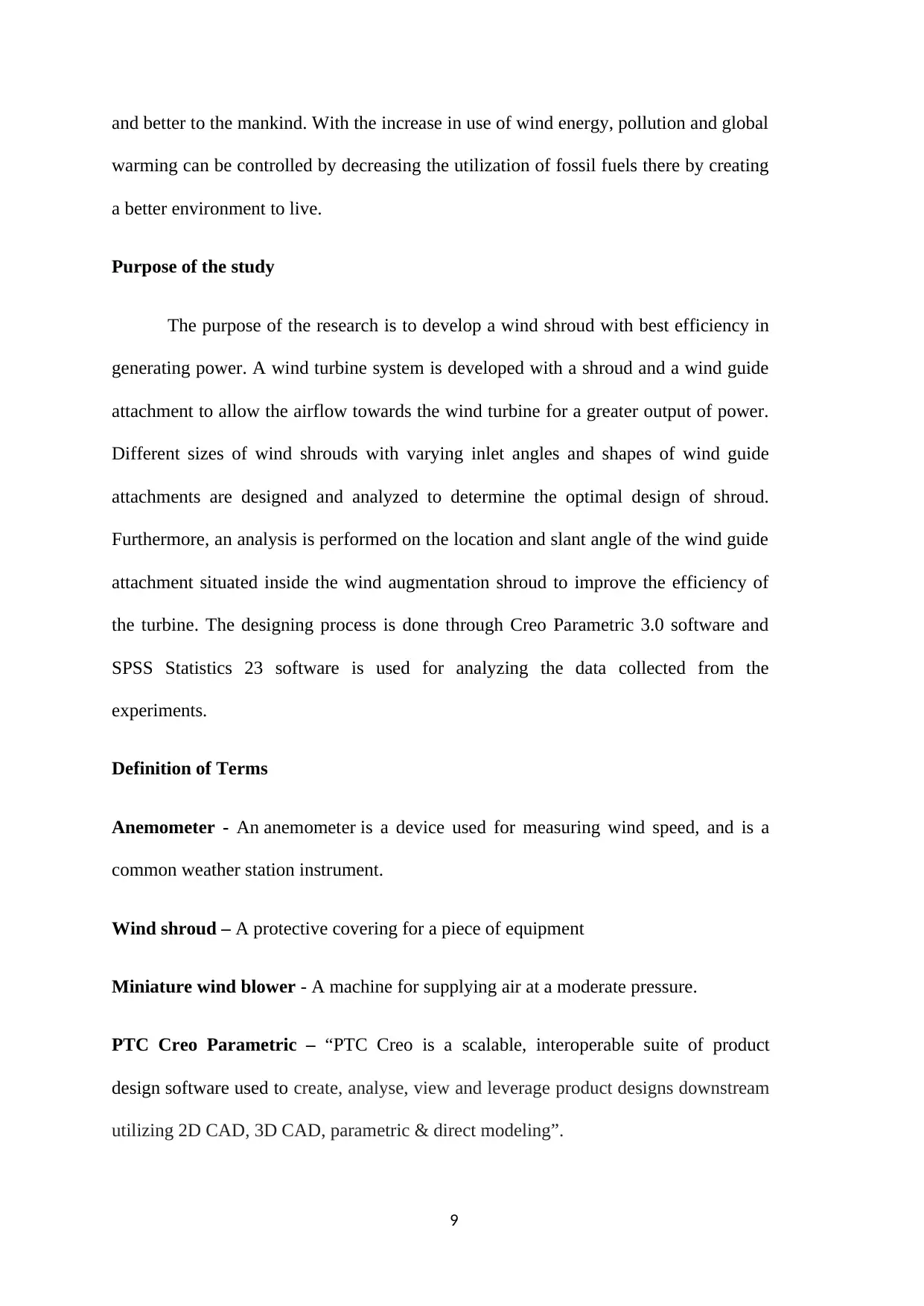
and better to the mankind. With the increase in use of wind energy, pollution and global
warming can be controlled by decreasing the utilization of fossil fuels there by creating
a better environment to live.
Purpose of the study
The purpose of the research is to develop a wind shroud with best efficiency in
generating power. A wind turbine system is developed with a shroud and a wind guide
attachment to allow the airflow towards the wind turbine for a greater output of power.
Different sizes of wind shrouds with varying inlet angles and shapes of wind guide
attachments are designed and analyzed to determine the optimal design of shroud.
Furthermore, an analysis is performed on the location and slant angle of the wind guide
attachment situated inside the wind augmentation shroud to improve the efficiency of
the turbine. The designing process is done through Creo Parametric 3.0 software and
SPSS Statistics 23 software is used for analyzing the data collected from the
experiments.
Definition of Terms
Anemometer - An anemometer is a device used for measuring wind speed, and is a
common weather station instrument.
Wind shroud – A protective covering for a piece of equipment
Miniature wind blower - A machine for supplying air at a moderate pressure.
PTC Creo Parametric – “PTC Creo is a scalable, interoperable suite of product
design software used to create, analyse, view and leverage product designs downstream
utilizing 2D CAD, 3D CAD, parametric & direct modeling”.
9
warming can be controlled by decreasing the utilization of fossil fuels there by creating
a better environment to live.
Purpose of the study
The purpose of the research is to develop a wind shroud with best efficiency in
generating power. A wind turbine system is developed with a shroud and a wind guide
attachment to allow the airflow towards the wind turbine for a greater output of power.
Different sizes of wind shrouds with varying inlet angles and shapes of wind guide
attachments are designed and analyzed to determine the optimal design of shroud.
Furthermore, an analysis is performed on the location and slant angle of the wind guide
attachment situated inside the wind augmentation shroud to improve the efficiency of
the turbine. The designing process is done through Creo Parametric 3.0 software and
SPSS Statistics 23 software is used for analyzing the data collected from the
experiments.
Definition of Terms
Anemometer - An anemometer is a device used for measuring wind speed, and is a
common weather station instrument.
Wind shroud – A protective covering for a piece of equipment
Miniature wind blower - A machine for supplying air at a moderate pressure.
PTC Creo Parametric – “PTC Creo is a scalable, interoperable suite of product
design software used to create, analyse, view and leverage product designs downstream
utilizing 2D CAD, 3D CAD, parametric & direct modeling”.
9
⊘ This is a preview!⊘
Do you want full access?
Subscribe today to unlock all pages.

Trusted by 1+ million students worldwide
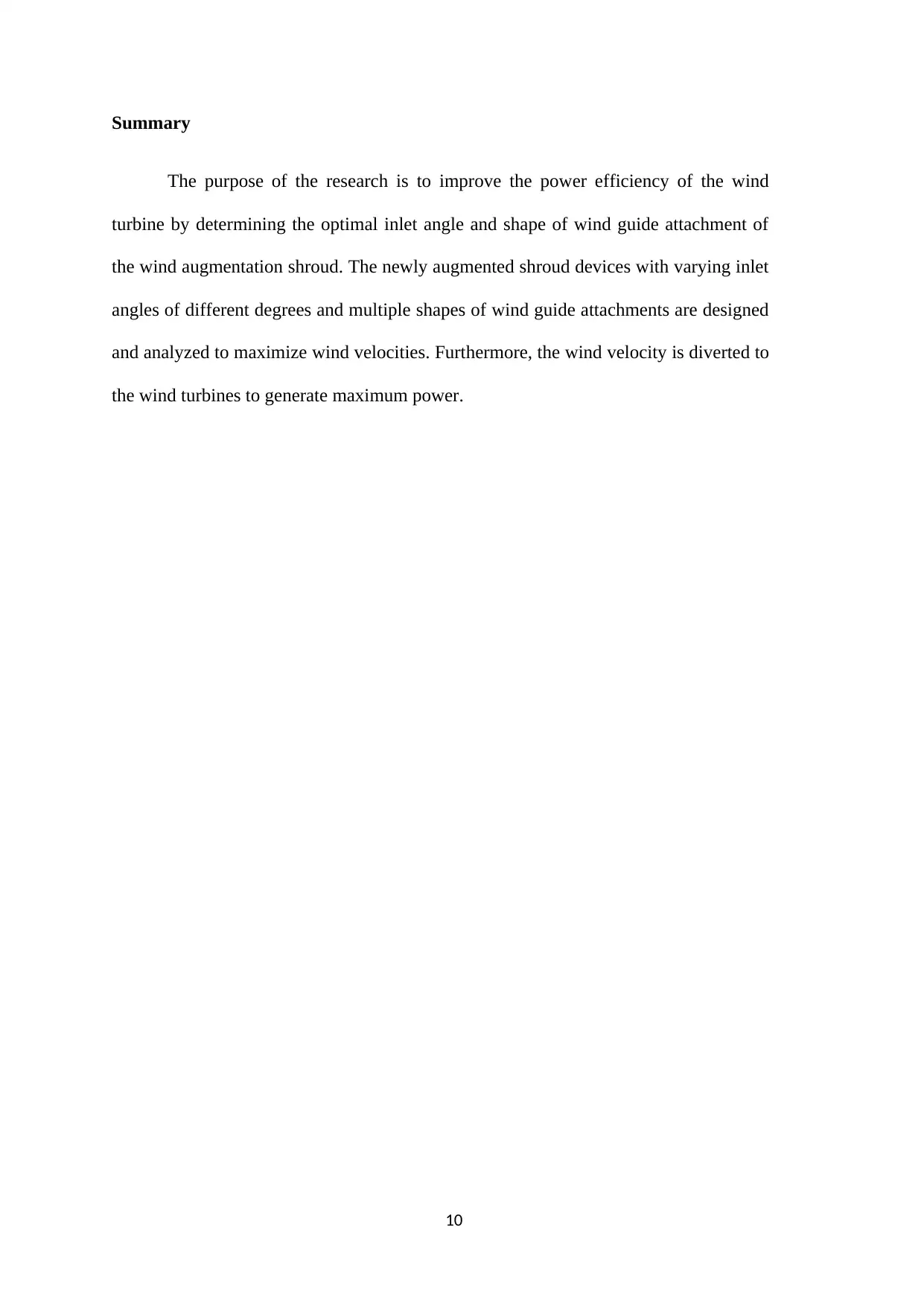
Summary
The purpose of the research is to improve the power efficiency of the wind
turbine by determining the optimal inlet angle and shape of wind guide attachment of
the wind augmentation shroud. The newly augmented shroud devices with varying inlet
angles of different degrees and multiple shapes of wind guide attachments are designed
and analyzed to maximize wind velocities. Furthermore, the wind velocity is diverted to
the wind turbines to generate maximum power.
10
The purpose of the research is to improve the power efficiency of the wind
turbine by determining the optimal inlet angle and shape of wind guide attachment of
the wind augmentation shroud. The newly augmented shroud devices with varying inlet
angles of different degrees and multiple shapes of wind guide attachments are designed
and analyzed to maximize wind velocities. Furthermore, the wind velocity is diverted to
the wind turbines to generate maximum power.
10
Paraphrase This Document
Need a fresh take? Get an instant paraphrase of this document with our AI Paraphraser
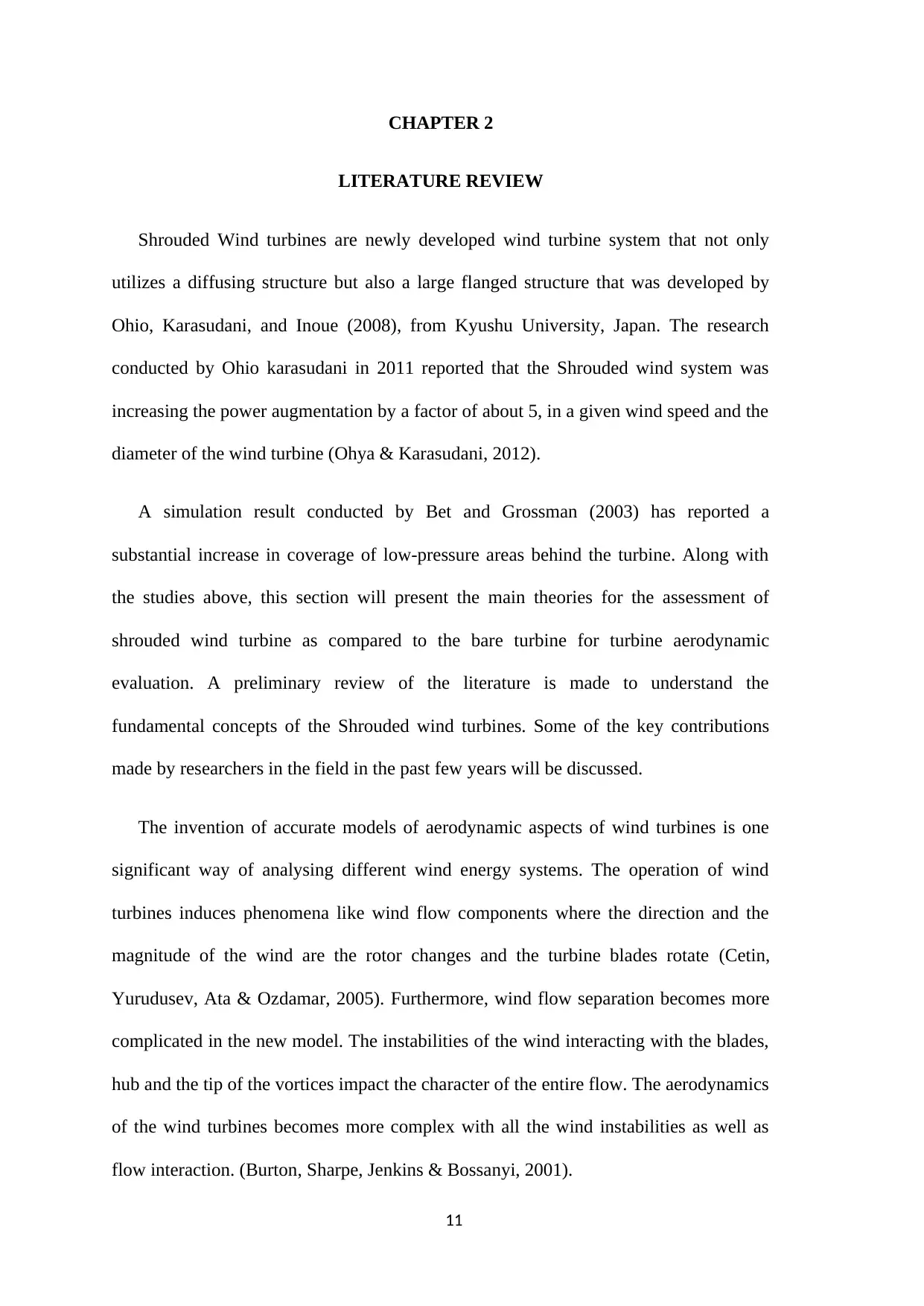
CHAPTER 2
LITERATURE REVIEW
Shrouded Wind turbines are newly developed wind turbine system that not only
utilizes a diffusing structure but also a large flanged structure that was developed by
Ohio, Karasudani, and Inoue (2008), from Kyushu University, Japan. The research
conducted by Ohio karasudani in 2011 reported that the Shrouded wind system was
increasing the power augmentation by a factor of about 5, in a given wind speed and the
diameter of the wind turbine (Ohya & Karasudani, 2012).
A simulation result conducted by Bet and Grossman (2003) has reported a
substantial increase in coverage of low-pressure areas behind the turbine. Along with
the studies above, this section will present the main theories for the assessment of
shrouded wind turbine as compared to the bare turbine for turbine aerodynamic
evaluation. A preliminary review of the literature is made to understand the
fundamental concepts of the Shrouded wind turbines. Some of the key contributions
made by researchers in the field in the past few years will be discussed.
The invention of accurate models of aerodynamic aspects of wind turbines is one
significant way of analysing different wind energy systems. The operation of wind
turbines induces phenomena like wind flow components where the direction and the
magnitude of the wind are the rotor changes and the turbine blades rotate (Cetin,
Yurudusev, Ata & Ozdamar, 2005). Furthermore, wind flow separation becomes more
complicated in the new model. The instabilities of the wind interacting with the blades,
hub and the tip of the vortices impact the character of the entire flow. The aerodynamics
of the wind turbines becomes more complex with all the wind instabilities as well as
flow interaction. (Burton, Sharpe, Jenkins & Bossanyi, 2001).
11
LITERATURE REVIEW
Shrouded Wind turbines are newly developed wind turbine system that not only
utilizes a diffusing structure but also a large flanged structure that was developed by
Ohio, Karasudani, and Inoue (2008), from Kyushu University, Japan. The research
conducted by Ohio karasudani in 2011 reported that the Shrouded wind system was
increasing the power augmentation by a factor of about 5, in a given wind speed and the
diameter of the wind turbine (Ohya & Karasudani, 2012).
A simulation result conducted by Bet and Grossman (2003) has reported a
substantial increase in coverage of low-pressure areas behind the turbine. Along with
the studies above, this section will present the main theories for the assessment of
shrouded wind turbine as compared to the bare turbine for turbine aerodynamic
evaluation. A preliminary review of the literature is made to understand the
fundamental concepts of the Shrouded wind turbines. Some of the key contributions
made by researchers in the field in the past few years will be discussed.
The invention of accurate models of aerodynamic aspects of wind turbines is one
significant way of analysing different wind energy systems. The operation of wind
turbines induces phenomena like wind flow components where the direction and the
magnitude of the wind are the rotor changes and the turbine blades rotate (Cetin,
Yurudusev, Ata & Ozdamar, 2005). Furthermore, wind flow separation becomes more
complicated in the new model. The instabilities of the wind interacting with the blades,
hub and the tip of the vortices impact the character of the entire flow. The aerodynamics
of the wind turbines becomes more complex with all the wind instabilities as well as
flow interaction. (Burton, Sharpe, Jenkins & Bossanyi, 2001).
11
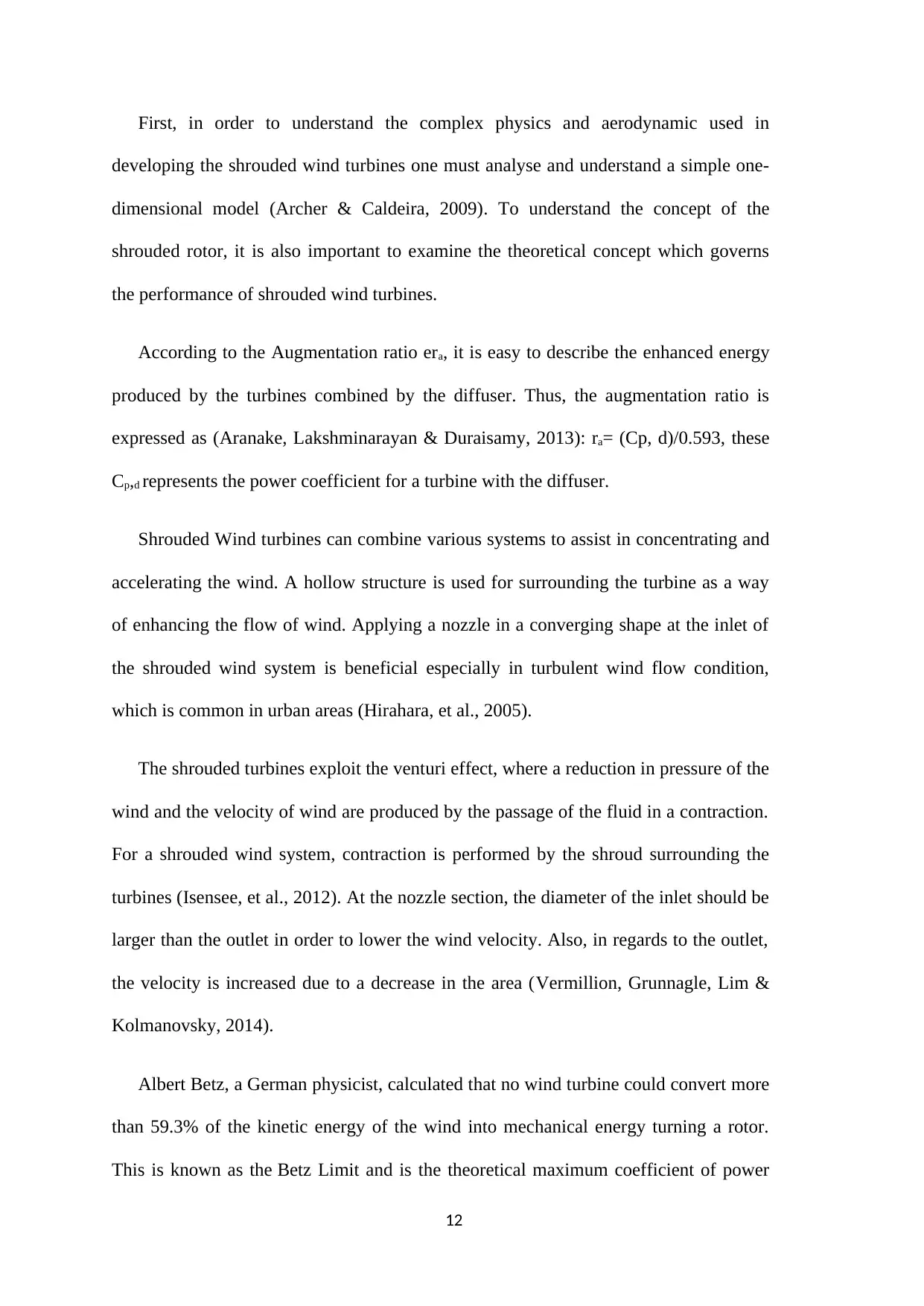
First, in order to understand the complex physics and aerodynamic used in
developing the shrouded wind turbines one must analyse and understand a simple one-
dimensional model (Archer & Caldeira, 2009). To understand the concept of the
shrouded rotor, it is also important to examine the theoretical concept which governs
the performance of shrouded wind turbines.
According to the Augmentation ratio era, it is easy to describe the enhanced energy
produced by the turbines combined by the diffuser. Thus, the augmentation ratio is
expressed as (Aranake, Lakshminarayan & Duraisamy, 2013): ra= (Cp, d)/0.593, these
Cp,d represents the power coefficient for a turbine with the diffuser.
Shrouded Wind turbines can combine various systems to assist in concentrating and
accelerating the wind. A hollow structure is used for surrounding the turbine as a way
of enhancing the flow of wind. Applying a nozzle in a converging shape at the inlet of
the shrouded wind system is beneficial especially in turbulent wind flow condition,
which is common in urban areas (Hirahara, et al., 2005).
The shrouded turbines exploit the venturi effect, where a reduction in pressure of the
wind and the velocity of wind are produced by the passage of the fluid in a contraction.
For a shrouded wind system, contraction is performed by the shroud surrounding the
turbines (Isensee, et al., 2012). At the nozzle section, the diameter of the inlet should be
larger than the outlet in order to lower the wind velocity. Also, in regards to the outlet,
the velocity is increased due to a decrease in the area (Vermillion, Grunnagle, Lim &
Kolmanovsky, 2014).
Albert Betz, a German physicist, calculated that no wind turbine could convert more
than 59.3% of the kinetic energy of the wind into mechanical energy turning a rotor.
This is known as the Betz Limit and is the theoretical maximum coefficient of power
12
developing the shrouded wind turbines one must analyse and understand a simple one-
dimensional model (Archer & Caldeira, 2009). To understand the concept of the
shrouded rotor, it is also important to examine the theoretical concept which governs
the performance of shrouded wind turbines.
According to the Augmentation ratio era, it is easy to describe the enhanced energy
produced by the turbines combined by the diffuser. Thus, the augmentation ratio is
expressed as (Aranake, Lakshminarayan & Duraisamy, 2013): ra= (Cp, d)/0.593, these
Cp,d represents the power coefficient for a turbine with the diffuser.
Shrouded Wind turbines can combine various systems to assist in concentrating and
accelerating the wind. A hollow structure is used for surrounding the turbine as a way
of enhancing the flow of wind. Applying a nozzle in a converging shape at the inlet of
the shrouded wind system is beneficial especially in turbulent wind flow condition,
which is common in urban areas (Hirahara, et al., 2005).
The shrouded turbines exploit the venturi effect, where a reduction in pressure of the
wind and the velocity of wind are produced by the passage of the fluid in a contraction.
For a shrouded wind system, contraction is performed by the shroud surrounding the
turbines (Isensee, et al., 2012). At the nozzle section, the diameter of the inlet should be
larger than the outlet in order to lower the wind velocity. Also, in regards to the outlet,
the velocity is increased due to a decrease in the area (Vermillion, Grunnagle, Lim &
Kolmanovsky, 2014).
Albert Betz, a German physicist, calculated that no wind turbine could convert more
than 59.3% of the kinetic energy of the wind into mechanical energy turning a rotor.
This is known as the Betz Limit and is the theoretical maximum coefficient of power
12
⊘ This is a preview!⊘
Do you want full access?
Subscribe today to unlock all pages.

Trusted by 1+ million students worldwide
1 out of 20
Related Documents
Your All-in-One AI-Powered Toolkit for Academic Success.
+13062052269
info@desklib.com
Available 24*7 on WhatsApp / Email
![[object Object]](/_next/static/media/star-bottom.7253800d.svg)
Unlock your academic potential
Copyright © 2020–2025 A2Z Services. All Rights Reserved. Developed and managed by ZUCOL.





